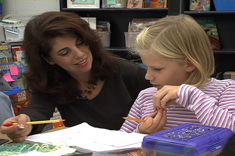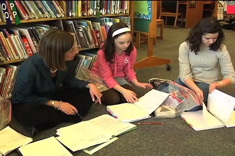I began last summer in two slumps: a running slump and a writing slump. I injured my lower back in early May and could not run for about six weeks. At the same time, life became hectic, and for many reasons, I seemed to lose my writing momentum. I was feeling bad about both and wondering how I was going to get back in the saddle. I can proudly say that eight weeks later, I was back on track with both! As I reflect on how I came out of my slumps, I see that in many ways, my experience paralleled that of students who have writing slumps in the classroom.
Get It on the Calendar!
The first thing I had to do was make time for these activities. It is amazing how quickly we can refill the time we had allocated to one activity with something else. I had to look at my daily schedule and actually block in times for myself to run and write. It took me at least two weeks to get into a routine that was working for me again. I need my routine to be regular and predictable. If it is not, I tend to become sidetracked and have a difficult time staying committed. I also find that I need to schedule at least three sessions per week for each activity. With fewer than three, I don’t establish a good pace, and find myself skipping days.
Author Amos Oz once said, “I write when I’m inspired—and I see to it that I’m inspired every morning at 9 a.m.” I think our students need the same regular, predicable routine when it comes to writing workshop. To live a writerly life, kids need to write regularly. If kids are writing only once or twice per week, they cannot remember what they are writing and they lose sight of their vision for that draft or topic. Kids need to expect when to write as well, so that they are thinking about writing between their sessions.
When I first started writing again, I had a lot of difficulty coming up with topics because I had not been thinking about and noticing good topics all around me. A week or two back into it, the ideas came flooding in. I was thinking like a writer again. Ideally, students should write four to five times a week. I have seen it done with three times per week, but it puts a big burden on the students to maintain momentum in their writing, especially in grades three to five. If teachers think time is too tight to allow for writing workshop four times a week every week, I often recommend having it four to five times a week for six to eight weeks and then taking a four-week break. I think that works better than twice a week all year.
Find a Friend
Getting out of bed at 5:00 a.m. to get out of a slump is nearly impossible, but if you know someone is out there waiting for you—you get out of bed! I always find it motivating to have a partner help me get out of a slump—someone to check in with, collaborate with, commiserate with, and celebrate with. Some days are harder for one partner and the other bears the weight for both. Then other days the favor is returned.
I have a running partner I meet with some mornings. If our schedules are tight and we cannot run together, we share when we plan to run and check in with each other on our progress at the end of the week. If one of us is having difficulty getting out there, we brainstorm and help that person get back on track. The act of checking in and depending on each other really motivates me to stick to my schedule and meet my goal.
I have a similar support system with my writing. Tammy Mulligan and I meet to talk about possible topics and brainstorm ideas. We each choose an idea to try to draft, and set a deadline. We then send each other whatever we have on that date. If one of us has nothing, we talk about what got in the way—the topic, our schedule, a family crisis, and so on. We then brainstorm solutions to the problems together and try again. These scheduled check-ins help keep us motivated and on track.
In classrooms, I have also found that having kids work in partnerships and small groups during writing workshop is really motivating. When I invited kids to talk about specific craft or revision techniques, I discovered that they loved talking with each other about what they were trying and showing each other what strategies or mentor texts were helping them. Students began forming their own groups around common goals. These groups met to share ideas. I also observed students suggesting that a friend “go talk with Steven, because he was having trouble with that, too, and he found some good ways to do that.” Certain students developed expertise in specific areas and were sought out for advice and instruction. The students taught each other, and reflected on the process of writing together.
It was great that the students began to teach each other, but what I found truly remarkable was the support they gave one another. Students began spontaneously checking in with each other about how their pieces were going, whether they had found a topic, or which lead they had chosen. The classroom grew into a community of writers who enjoyed talking and planning with one another. The fact that their peers were invested in their writing motivated kids to get out of their slumps and write! Everything is easier when someone is checking in with you.
Choose What You Enjoy
When you are trying to get out of a slump, don’t make things harder for yourself. Think about what you like and make sure that is part of the plan. If you have a favorite route, time of day, or running shoes, make sure it is part of the plan to get back in the saddle. It is always easier to reengage when you feel comfortable and confident. When I began running again, I picked routes I knew really well. I like to run in the early morning, so I made sure my schedule allowed me at least two early morning slots. And for me . . . shopping always makes everything better, so new sneakers were definitely in order.
It was the same with my writing slump. Tammy and I were having a really tough time getting into a topic. We kept coming up with ideas, but they went nowhere or moved slowly. We kept abandoning pieces and were not holding ourselves accountable to our deadlines. We finally found a topic we enjoyed and had written about previously, and that was the breakthrough.
Some years ago at the National Council of Teachers of English annual meeting, I heard Katie Wood Ray speak about kids and topic choice. She said, “Why does everyone get so worked up about kids writing about the same topic? I have been writing about the same topic—writing—for my entire career, and no one seems to care. Why do we care when kids have passion around a topic?” When I am in classrooms, I often find that students who are in a slump are stuck because of topic issues. Either they have been assigned a certain topic or they’ve been told they need to find a topic different from the one they originally chose. So they get stuck and sit there, day after day, in a slump.
This makes me think of my slumps and what helps motivate me. I think students need to write to become better writers. If they have an idea to write about, why not just let them write? I think my best topics typically come to me when I am writing about familiar topics. The process of writing gets you thinking about other things to write about. Sometimes you just need to get your pen moving. When we assign or restrict topics, we may be giving our students one more hurdle to get over.
It is not easy to rebuild after you lose momentum. The most important thing is to find a way to start back up again. I do whatever it takes to make that happen. Once I am back into my routine, I can gradually be more flexible with my schedule and veer off onto new terrain. Giving our students the space and support they need to prevent and get out of slumps is really important. The sooner they get out, the sooner they too will be off and writing.









